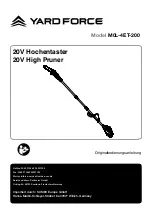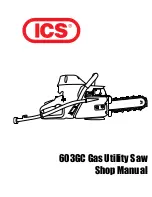
31
Inspect Your Workplace
• Inspect your work area, and keep it clean and safe. Clut-
tered areas and benches invite accidents.
• Avoid slippery floors, whether from floor waxes or spills.
• Never use the saw near flammable liquids, vapors or gases.
• Do not do layout, assembly, or setup work on the table
while the blade is spinning
Plan the Way You Will Push the Work Piece Through.
• Set the cutting tool as low as possible for the cut you’re
planning
• Push the work piece against the rotation of the blade.
Never feed material into the cutting tool from the rear of
the saw.
• Make sure that the off-cut (piece of tile that will be cut off)
has enough room to move sideways. Failure to do so may
result in the off-cut binding against the blade.
• When cutting irregularly shaped work pieces, plan your
work so it will not slip.
• Don’t overreach. Keep proper footing and balance at all
times.
• Always push the work piece all the way past the saw
blade.
Plan Your Cut
• Never cut freehand. Always use either a rip fence or a fix-
ture to position and guide the work so that it won’t twist or
bind on the blade.
• Keep the table and surrounding area clear, except for the
tile to be cut.
• Use extra caution with large, very small, or awkward work
pieces.
• Never cut more than one tile at a time.
• Never turn your tile saw “ON” before clearing everything
except the work piece and related support devices off of
the table.
• Never cut pieces too small to be held securely against the
rip fence while leaving enough space for the hands to be a
safe distance from the blade.
• Never allow the blade to run dry. Failure to keep the water
tray topped off will result in possible over-heating of the
diamond blade.
Filling and Draining the Water Tray
CAUTION!
Having too little cooling water in the water tray may
damage the saw blade. Never turn on the machine or
plug in the water pump unless the water level reaches
the lowest scale marked on the water tray.
OPERATION
1. Insert the water plug into the hole of the water tray.
. Pour five gallons water into the water tray.
3. Secure the water tray lock (Fig. 4).
4. To insure proper operation, make sure that the water
level in the water tray is at least as high as the lowest
scale marked on the water tray.
5. Do not add chemicals or detergents to the water.
WATER TRAY LOCK CLIP
WATER TRAY LOCK CLIP
Fig. 4
To drain the water:
1. Loosen the lock clip.
. Pull out the water tray approximately 5 inches.
3. Place a five-gallon bucket beneath the water plug.
4. Remove the water plug
5. Allow the water to flow into the bucket.
Or, you can remove the water pump from the water tray,
loosen the lock clip, remove the water tray, and pour the
water out.
Power Supply
Power tool plugs must match the outlet.
WARNING:
Test before each use.
1. Plug ground-fault-circuit-interruptor (GFCI) into a power
outlet: the indicator should turn on (Fig. 43).
. Press the test button: the indicator should turn off.
3. Press the reset button again for use. Do not use if the
above test fails.
This device does not protect against electrical shock due to
contact with short circuits or faulty wiring in the power supply.
Fig. 43
Содержание WTS2000L
Страница 39: ...39 Exploded Drawings and parts lists WTS2000L Tile Saw...
Страница 41: ...41 Notes...
Страница 42: ...42 Notes...
Страница 43: ...43 Notes...














































